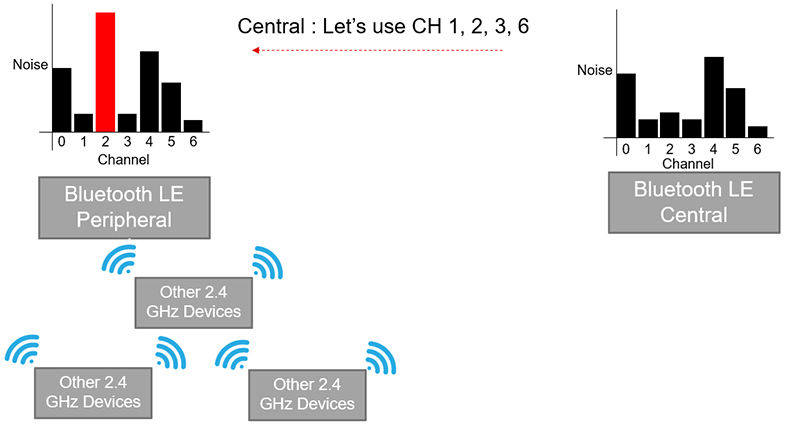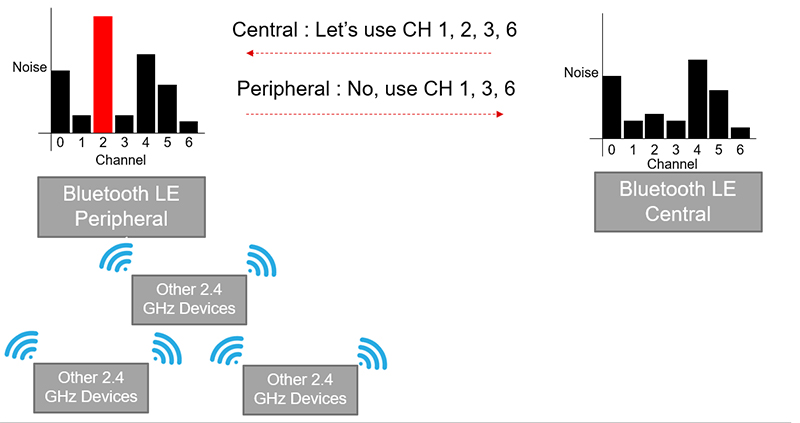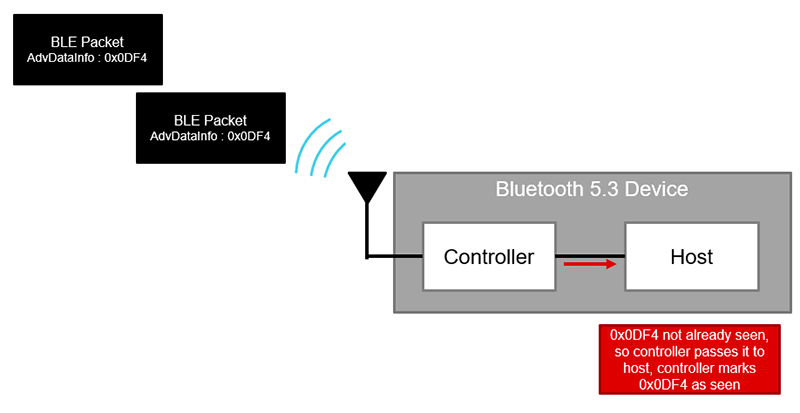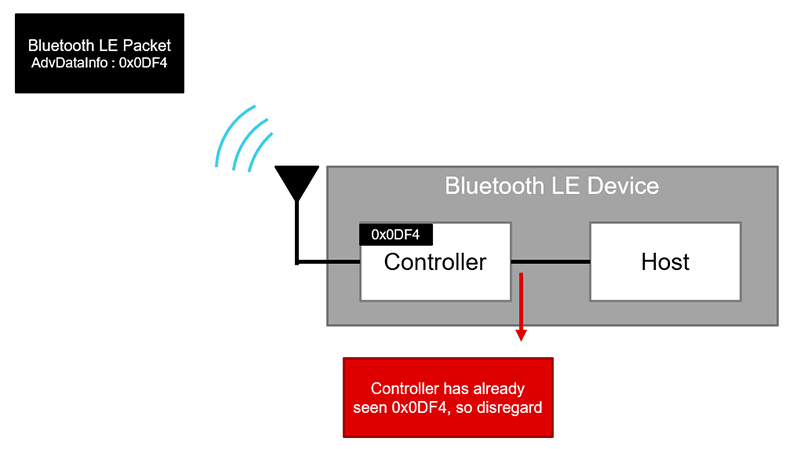SSZT113 december 2021
Developers have more flexibility and configuration options than ever with the Bluetooth Special Interest Group's (SIG) release of version 5.3 of the Bluetooth Core Specification in July 2021. With this release come three updates to Bluetooth® Low Energy that can improve performance, reduce power and cut down on latency for devices. These improvements are relevant for all sorts of Bluetooth Low Energy applications and devices.
Join us as we dive into the details and potential applications of these three changes.
No. 1 Connection Subrating Increases Responsiveness
Bluetooth devices can set different durations for a connection interval, which is how much time the devices wait between successive connection events. Longer connection intervals save power by communicating less frequently in a given time, whereas shorter connection intervals are more responsive and can send more data in a given amount of time.
Changing the connection interval introduces latency. In practice, when devices want to change the connection interval, it takes at least six connection events to negotiate that change as shown in Figure 1.
 Figure 1 Delays When Changing
Connection Interval (
source
)
Figure 1 Delays When Changing
Connection Interval (
source
)The time taken up by these six events can be a problem when the connection interval is changing from long to short in response to an external measurement. If it takes six connection events to change the connection interval from 1 second 10 milliseconds, for example, then the user will have to wait six seconds for the change to occur.
If this happens in a time-sensitive application, say a brief sensor reading, that latency may be intolerable. But, with a connection subrating, the user can reduce the amount of time it takes to change from a long connection interval to a short connection interval. This happens by telling the central and peripheral to skip connection events depending on whether data was sent in the most recent connection event.
To use a subrated connection, the user must specify two parameters: subrate factor and continuation number. The subrate factor equals the number of unused connection events between used connection events. As shown in Figure 2, a connection event must be used every subrate factor regardless of whether there is data to transmit.
 Figure 2 Subrate Factor Tells Devices
When to Skip Connection Events (
source
)
Figure 2 Subrate Factor Tells Devices
When to Skip Connection Events (
source
)The continuation number equals the number of subsequent connections devices must respond to after a non-empty connection event (a connection event that transmits data between devices). Remember that not all connection events transmit data. Some are used just to keep the connection between the devices alive.
In Figure 3, the continuation number is 1. Notice how after a non-empty connection event (5), connections continue to be processed until an empty connection event (8), after which point they are unused until the next subrated connection event (10).
 Figure 3 Continuation Number Tells
Connection Not to Skip 6 and 7
Figure 3 Continuation Number Tells
Connection Not to Skip 6 and 7This reduces the delay associated with changing the connection interval because it no longer requires a negotiation between devices. It can now happen dynamically for each connection event.
No. 2 Channel Classification from Central and Peripheral Devices Improves Reliability
The Bluetooth® protocol breaks up the 2.4 GHz frequency band into smaller 2 MHz channels that devices hop across when communicating. Using this spread-spectrum strategy reduces packet collisions and industrial, scientific and medical radio (ISM) band interference because devices change channels frequently using either a semi-random or an ordered sequence. This sequence of channels used is called the channel map.
Previously, the central device decided the channel map by itself. It would scan the different channels in the 2.4 GHz band to inform which channels would be viable for traffic, as depicted in Figure 4. Channels with more traffic would be excluded from the map to reduce the probability of packet collisions.
 Figure 4 Before the Channel
Classification Enhancement, the Central Device Alone Sets the Channel
Map
Figure 4 Before the Channel
Classification Enhancement, the Central Device Alone Sets the Channel
MapSince the central device decided the priority, the peripheral device had no say in which channels were being used. As Bluetooth devices can communicate over increasingly longer distances, the channel conditions for the peripheral and the central may diverge. This divergence becomes problematic if the channel map includes channels that do not appear to have significant interference with respect to the central's location, but do have significant interference with respect to the peripheral's location, as shown in Figure 5.
 Figure 5 Before the Channel
Classification Enhancement, Channel 2 Is Noisy to the Peripheral, but the
Central Does Not Know and Includes It in the Channel Map
Figure 5 Before the Channel
Classification Enhancement, Channel 2 Is Noisy to the Peripheral, but the
Central Does Not Know and Includes It in the Channel MapWith the introduction of the coded PHY to Bluetooth LE, the amount of distance Bluetooth LE connections can cover has grown drastically. Take for example electronic shelf-labels. Having just the central device control the channel map makes less sense as tags are placed all over a retail space. Channel conditions may vary greatly from one peripheral's location to another, but none of that will be reflected in the channel map, which is set by the central alone.
With the new channel classification enhancement, the peripheral can report its channel classifications to the central device to influence the channel map used in the connection between the peripheral and central. This reduces the risk of losing packets when either device is operating in congested environments by ensuring the environmental conditions of both devices are taken into account when setting the channel map.
 Figure 6 With the Channel
Classification Enhancement, the Peripheral Can Reject the Noisy Channel 2 from
the Channel Map
Figure 6 With the Channel
Classification Enhancement, the Peripheral Can Reject the Noisy Channel 2 from
the Channel MapNo. 3 Periodic Advertising Enhancement Saves Power
Bluetooth® LE devices that use periodic advertising typically send information multiple times to increase the transmission's diversity and enhance the probability that a scanning device decodes it correctly. Accordingly, listener devices may receive multiple copies of the same packet and wastes power decoding the same information multiple times.
Now, in periodic advertising, transmitting devices can include an AdvDataInfo field in the packets they send to allow receiving devices to check whether they've already received this packet before. If so, the device stops receiving, which saves power on the radio layer. This practice also lets the device avoid passing the redundant packet it up to the host, too. By filtering what gets passed to the host, low-power devices can conserve more energy by ignoring redundant packets.
This is especially useful for battery powered Bluetooth LE devices that listen to Bluetooth LE beacons, like asset tracking tags. They want to reduce power consumption to as low as possible to preserve battery life, so they cannot afford to waste power processing redundant information. With this update, they will be able to achieve even better energy efficiency than before.
 Figure 7 First packet gets
processed
Figure 7 First packet gets
processed Figure 8 Second Packet Rejected
Figure 8 Second Packet RejectedAs an associate member of the Bluetooth SIG, TI is able to advocate for the interests of our customers and have a distinct vantage point that helps us stay ahead of innovations. With our products and expertise, we can help you maximize the benefits of Bluetooth Low Energy including:
- Increased responsiveness while maintaining a low power profile through connection subrating.
- Improved reliability by giving the peripheral the option to influence the channel map.
- Reduced power consumption by ignoring redundant messages.
For more information about Bluetooth Low Energy and TI's suite of Low-Power Bluetooth Low Energy Microcontrollers, visit TI's Bluetooth products page.